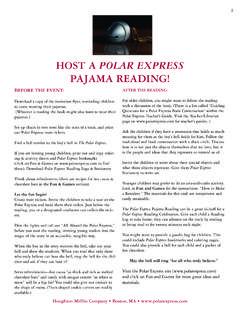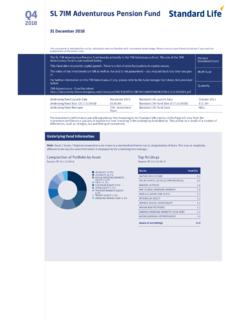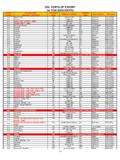Transcription of Method 1664, Revision B: n-Hexane Extractable Material ...
1 United States Office of Water Environmental Protection Agency (4303) February 2010. Method 1664, Revision B: n- hexane Extractable Material (HEM; Oil and Grease) and Silica Gel Treated n- hexane Extractable Material (SGT-HEM; Non-polar Material ) by Extraction and Gravimetry February 2010. Environmental Protection Agency Office of Water (4303T). 1200 Pennsylvania Avenue, NW. Washington, DC 20460. EPA-821-R-10-001. Method 1664, Revision B. Acknowledgments Revision B of this Method was prepared by the Engineering and Analysis Division within EPA's Office of Water. EPA gratefully acknowledges assistance from DynCorp Information and Enterprise Technology in the preparation of the earlier versions. Additionally, EPA gratefully acknowledges Xenosep Technologies for their comments and review.
2 Disclaimer This Method has been reviewed by the Engineering and Analytical Support Branch of the Engineering and Analysis Division (EAD) in OST and approved for publication. Mention of trade names or commercial products does not constitute and endorsement or recommendation for use. Contact Questions concerning this Method or its application should be directed to: CWA Methods Team, or Lemuel Walker EPA. Engineering and Analysis Division, MC 4303T. Office of Science and Technology 1200 Pennsylvania Avenue NW. Washington, 20460. Additional copies of this Method are available at: February 2010 i Method 1664, Revision B. Table of Contents Introduction .. iii Scope and Application .. 1. Summary of Method .. 6. 6. Interferences .. 6. Safety.
3 7. Equipment and Supplies .. 7. Reagents and Standards .. 10. Sample Collection, Preservation, and Storage .. 11. Quality Control .. 12. Calibration and 19. Procedure .. 19. Data Analysis and Calculations .. 24. Method Performance .. 25. Pollution 25. Waste Management .. 25. References .. 26. Tables .. 27. Glossary of Definitions and Purposes .. 27. February 2010 ii Method 1664, Revision B. Introduction EPA withdrew all oil and grease methods using chlorofluorocarbon-113 (CFC-113; Freon-113) as an extraction solvent in the final rule published March 7, 2007; 72 FR 11199, including approved Method , and Methods and , which were never approved for use at 40 CFR 136 even though they were listed in the now outdated Methods for Chemical Analysis of Water and Wastes (EPA 600/4-79- 020; NTIS PB84-128677).
4 As such, EPA Method 1664, Revision B: n- hexane Extractable Material (HEM; Oil and Grease) and Silica Gel Treated n- hexane Extractable Material (SGT-HEM; Non-polar Material ) is the only approved EPA Method for the measurement of oil and grease. The term n- hexane Extractable Material (HEM; Oil and Grease) reflects the Material extracted by n- hexane as that which is being measured using Method 1664 and that the common name oil and grease is being retained because of its familiarity to the analytical community. The term Silica-gel Treated n- hexane Extractable Material (SGT-HEM; Non-polar Material ) designates the substances that remain after n- hexane Extractable Material is exposed to silica gel. In the final rule published May 14, 1999 (64.)
5 FR 26315) the term Non-polar Material (NPM) was chosen to avoid confusion in the analytical community with the term total petroleum hydrocarbons (TPH), as this term can measure a different property or Material , or employ different analytical techniques, including infrared spectroscopy and gas chromatography. Method 1664B is a performance-based Method applicable to the measurement of the Method -defined parameters HEM and SGT-HEM from aqueous matrices and requires the use of n- hexane as the extraction solvent, gravimetry as the determinative technique, and includes additional QC procedures designed to monitor precision and accuracy. Although analyst modification of an approved, Method - defined analyte Method is generally not allowed, some performance-based changes may be acceptable.
6 However, it should be noted that due to the nature of some discharge/waste streams, not all samples may be amenable to analysis with a modified Method , ( , SPE as the modification) and for these samples, 1664B should be applied as written. The purpose of this update is to provide additional information to improve Method performance and more clearly define by example: 1. Modifications that are allowed for nationwide use without prior EPA review (40 CFR ). 2. Modifications that are not allowed. The modifications listed below and included in Section are not meant to be an exhaustive list of all possible modifications to the Method , but rather they represent modifications which have been presented to the EPA by various stakeholders and our determination of their acceptability for use in Method 1664B.
7 In recognition of advances that are occurring in analytical technology, the laboratory is permitted certain options to improve separations or lower the costs of measurements, provided that all performance specifications are met. These options include alternate extraction and concentration devices and procedures such as continuous liquid-liquid extraction (CLLE), evaporation, Kuderna-Danish concentration and solid-phase extraction (SPE). Alternate determinative techniques, such as immunoassay and infrared spectroscopy, and changes that degrade Method performance or change the chemistry of the Method including the use of extraction solvents other than n- hexane (85% minimum purity, min. saturated C6 isomers, residue less than 1 mg/L see Section ) are not allowed.
8 If an analytical technique other than the techniques specified in this Method is used, that technique must have a specificity equal to or better than the specificity of the techniques in this Method for HEM and/or SGT-HEM in the sample of interest. Specificity is defined as producing results equivalent to the results produced by this Method for analytical standards (Section ) and, where applicable, environmental samples (Section ), and that meet all of the QC criteria stated in this Method . Any modification of this Method , beyond those expressly permitted, shall be considered a major modification subject to application and approval of alternate test procedures under 40 CFR and February 2010 iii Method 1664, Revision B. Method 1664, Revision B.
9 N- hexane Extractable Material (HEM; Oil and Grease) and Silica Gel Treated n- hexane Extractable Material (SGT-HEM;. Non-polar Material ) by Extraction and Gravimetry Scope and Application This Method is for determination of n- hexane Extractable Material (HEM; oil and grease) and n- hexane Extractable Material that is not adsorbed by silica gel (SGT-HEM; non-polar Material ) in surface and saline waters and industrial and domestic aqueous wastes. Extractable materials that may be determined are relatively non-volatile hydrocarbons, vegetable oils, animal fats, waxes, soaps, greases, and related materials. The Method is based on prior Environmental Protection Agency (EPA) methods for determination of oil and grease and total petroleum hydrocarbons.
10 (References and ). This Method is for use in the Environmental Protection Agency's (EPA's) survey and monitoring programs under the Clean Water Act; the Resource Conservation and Recovery Act; the Comprehensive Environmental Response, Compensation, and Liability Act; and other EPA. regulatory programs. Oil and grease is a conventional pollutant under the Clean Water Act and codified at 40 CFR The term n- hexane Extractable Material reflects that this Method can be used to determine materials other than oils and greases. Similarly, the term silica gel treated n- hexane Extractable Material reflects that this Method can be used to determine Material that is not adsorbed by silica gel (non-polar Material ). This Method is not applicable to measurement of materials that volatilize at temperatures below approximately 85 C.

















